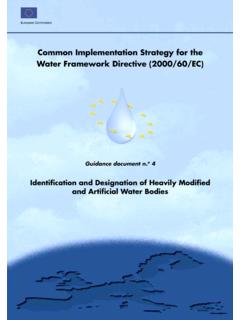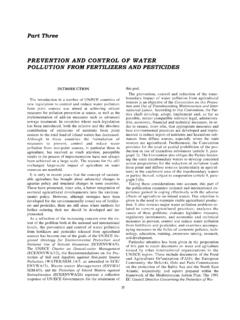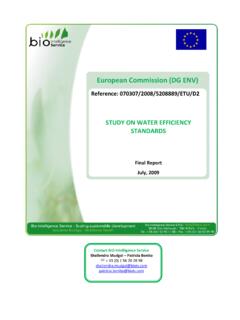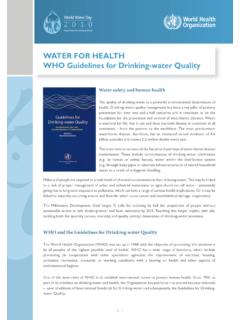Transcription of Guide to the NEW Recreational Craft Directive …
1 Guide to the NEW Recreational Craft Directive 2013/53/EUSpring 2015 Guide to the guideI am colour code and the icons above will help you recognise the specific sections relevant to you, depending on whether you are a manufacturer, authorised representative, importer, distributor, private importer or an end user. Sections that are relevant to all readers are left in or authorised representativeImporterDistributorPrivate importerGuide to the NEW Recreational Craft Directive 2013/53/EU2 Introduction This simple Guide outlines what the main changes are in the new Directive compared to previous directives and takes you through the various obligations you may have, depending on whether you are a manufacturer, commercial or private importer, distributor (dealer) or buyer. It aims at providing you with a good understanding of the EU rules and how to comply with the essential requirements.
2 This Guide is also a useful tool for potential buyers who can make sure the product they plan to acquire is safe, clean and compliant with the EU rules. There are several ways to use this Guide : The short Guide gives a checklist to make sure your product is compliant and safe. It is particularly useful if you are an importer, a distributor or a buyer The test will help you assess your knowledge The thematic chapters provide more information on the legal framework, the essential requirements and how to comply with them. They should answer most questions that manufacturers, authorised representatives, importers and private importers may 15 years of enabling the free trade of boats, engines and components on the EU single market, the EU Directive on Recreational Craft 94/25/EC, as amended by the Directive 2003/44/EC, was replaced by the new Directive 2013/53/EU published on 28 December to the NEW Recreational Craft Directive 2013/53/EU3 Since the Directive s first application in 1996, the boating industry has evolved exponentially and a number of product innovations, such as hybrid or electric propulsion, became more common on the various European markets.
3 Big environmental challenges like climate change and air quality influenced, and continue to influence, policy-making in Europe in every sector, including the boating industry. Additionally, the European Union revised its approach to product legislation and adopted the New Legal Framework in new Directive includes the changes brought by the New Legal Framework, all the necessary elements for effective conformity assessment procedures and CE-marking, accreditation of notified bodies (the certifying bodies), and market surveillance including the control of products from outside the Union, creating a more coherent regulation for the EU single market. The Directive s essential requirements were modernised and clarified to reflect the highest state-of-the-art in boatbuilding and equipment the previous Directive , the new text sets all the conditions for the first time sale and putting into service of boats, engines and certain components in Europe.
4 All the Member States of the European Union, as well as the countries of the European Economic Area (Iceland, Liechtenstein, Norway) and Switzerland, apply the same legislation. It will therefore be mandatory to comply with all aspects of the EU Directive 2013/53/EU as this opens doors for the vast European market where products can be freely traded and acquired. Guide to the NEW Recreational Craft Directive 2013/53/EU4 There is one exemption to this calendar: small and medium sized enterprises producing outboard spark ignition (SI) propulsion engines with power equal to or less than 15kW will have an extra three years to adapt to the new EU rules on exhaust emission limits for engines. These companies will be allowed to continue producing and placing engines on the EU market that are compliant with Stage I limits for exhaust emissions until 17 January 2020 or authorised representativeLet s look at upcoming milestones.
5 TimelineBefore 18 January 2016 Member States are required to amend their national legislation and transpose all the requirements of the new DirectiveOn 18 January 2016 The old Directive 94/25/EC will be repealed and no longer applicable20162017 From 18 January 2017 onwardsOnly products that are compliant and tested according to the new Directive 2013/53/EU will be accepted Between 18 January 2016 and 17 January 2017 Companies will have a one-year transition during which they can place for the first time on the EU market boats, engines and components that are compliant and CE-marked according to either the old or the new Directives (this is meant to allow the sales of existing products) Guide to the NEW Recreational Craft Directive 2013/53 How to check the product is compliant and safe Watercraft builder s plate CE Marking Watercraft identification Propulsion engine identification Owner s manuals Written EU Declaration of ConformityTest Your Take our fun, interactive quiz (wifi access required)Legal changes brought by the New Legal Scope of the Directive2.
6 Definitions3. New responsibilities for economic operators Manufacturer s obligations Authorised representative s obligations Importer s obligations SPECIAL CASE: Importer selling under own name or trademark Distributor s obligations SPECIAL CASE: Distributor selling under own name or trademark The end user Private importer s obligations4. Placing a product on the market vs. making it available5. Improved traceability requirements Identification requirements for watercraft Identification requirements for engines Identification requirements for components6. CE marking and other marking requirementsThe Directive s Essential What an essential requirement is2. Main changes in the essential requirements New definitions of watercraft design categories Risk of falling overboard and means of reboarding Visibility from the main steering position Owner s manuals Buoyancy and flotation of multihull Craft Escape on multihull Craft in the event of inversion Outboard engines Electrical systems Prevention of sewage discharge Lower limits for engine exhaust emissions SPECIAL CASE: Three-year delay for small outboard enginesGuide to the NEW Recreational Craft Directive 2013/53/EU6 Identical limits for engine noise emissions3.
7 Using the harmonised standards4. Harmonised standards and presumption of conformity5. Other ways to comply with the essential requirementsConformity About conformity assessment procedures2. Overview of modules and procedures available Modules for design and construction of Recreational Craft (boats) Modules for design and construction of personal watercraft Modules for design and construction of components Modules for engine s exhaust emissions Modules for noise emissions3. Technical documentation4. The EU Declaration of Conformity SPECIAL CASE: Partly completed watercraft5. New responsibilities for notified bodiesStrengthening Market Surveillance in Consequences of Importer or distributor selling under own name or trademark2. Watercraft sold with its trailer3. Partly completed craft4. Craft built for own use5.
8 Exempted watercraft changing its intended purpose6. Major engine modification or Craft conversion7. Post construction assessmentUseful Information and EU Directive on Recreational Craft and personal watercraft Comparative table for essential requirements Harmonised standards The national competent authorities Notified bodies for conformity assessment The New Legal Framework General Product Safety Directive Consumer Rights Directive Legislation on product liabilityAbout the European Boating Industry ICOMIA to the NEW Recreational Craft Directive 2013/53/EU7 Quick guideHow to check if the product is compliant and safeTo help you rapidly identify non-compliant products, this short Guide gives you information on the documentation and markings to look out for. This is called the formal compliance check and can be performed by anyone, without needing any previous knowledge or expertise.
9 To ensure that the Craft you are importing, distributing or purchasing complies with the Directive , you should check the following items:Watercraft builder s plate Each watercraft (boat and personal watercraft) must carry a permanently affixed builder s plate, which is mounted separately to the watercraft identification builder s plate should contain the following information: Manufacturer s name, registered trade name or registered trademark, contact address CE marking Watercraft design category Manufacturer s maximum recommended load (fuel, water, provisions, miscellaneous equipment and people), excluding the weight of the contents of the fixed tanks when full, this should appear in kilograms. Number of persons recommended by the manufacturer for which the watercraft was designed to carry when under builder s plate is usually found inside the boat, for instance in the cockpit appearance of the builder s plate can vary according to manufacturers, but it should always display the above-mentioned information.
10 If the watercraft was not designed and built for the EU market, for instance second-hand imported boats or personal watercraft, it will have to individually undergo a post-construction assessment (PCA) with a notified body to establish whether it meets the Directive s requirements. If so, the builder s plate will contain the words post-construction assessment and the contact details of the notified body which has carried out the conformity assessment procedure will be mentioned instead of the manufacturer s to the NEW Recreational Craft Directive 2013/53/EU8CE markingThe following products are subject to CE marking when they are made available on the market or put into service: Watercraft ( boat and personal watercraft) Components (as listed in Annex II) Propulsion engines (internal combustion engines only) The CE marking is a key indicator (but not proof) of a product s compliance with the essential requirements of the Directive and the EU legislation requiring the CE marking.






